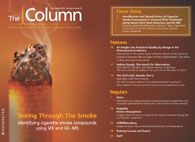LC–MS–MS Yields Information About Imperial Inca Child Sacrifice Practices
Scientists from the University of Bradford (Bradford, UK) have utilized liquid chromatography?tandem mass spectrometry (LC-MS-MS) to gain further insight into the child sacrifice practices of the Inca people.1 Their findings indicate the use of alcohol and cocaine (COC) as a method of victim sedation.

Scientists from the University of Bradford (Bradford, UK) have utilized liquid chromatography–tandem mass spectrometry (LC–MS–MS) to gain further insight into the child sacrifice practices of the Inca people.1 Their findings indicate the use of alcohol and cocaine (COC) as a method of victim sedation.
In 1999, three bodies were excavated from a sealed chamber at the Andean summit of Volcán Llullaillaco, on the border of Chile and Argentina. The bodies are estimated to have been buried approximately 500 years prior to excavation. Two of the bodies were identified to be around 4—5 years old, and were named the “Llullaillaco Boy” and “Lightening Girl”. The third was identified to be older, at around 13 years of age, and was named “Llullaillaco Maiden”.
The Imperial Inca capachocha rite of human sacrifice was fundamental to establishing social control of the Inca Empire on newly acquired regions; the positioning of the victims on peaks enforced control over an area. According to an earlier study published by the same team,2 over 100 shrines at Inca ritual sites have been recorded between 5200 m and 6700 m on significant peaks throughout the Andean mountain range. The association of specific sites with lightening strikes and volcanic activity is thought to have been key to their selection.
Lead author of the study Andrew Wilson said: “From later Colonial period accounts we have indications that children, often as young as four years old, and ‘acllas’, or chosen women selected around puberty, were donated for sacrifice by their parents and from communities which were under control of the Inca Empire.” He added: “One account suggests that this was an honour and that no sadness could be shown when the children were gifted, but the significance of these transactions as a mechanism of social control must have created a climate of fear amongst such communities.”
Coca leaves were found at the site, along with other “offerings”. Cut scalp hair samples, collected in 2003, were defrosted and prepared for LC–MS–MS. Three markers were tested for in the hair samples — COC, the major alkaloid in coca leaves; bezoylecgonine (BZE), the major metabolite of COC; and coca ethylene (COCE), formed in the presence of alcohol. Samples from self-reporting COC users in rehabilitation were used as positive controls. A volume of 5 µL of each sample extract was injected onto a reversed-phase column and analysed by triple quadrupole mass spectrometry using electrospray ionization in positive ion mode.
Wilson told The Column: “Our approach enabled us to use the minimum of hair to safeguard their exceptionally well-preserved remains, with each segment along these hairs representing roughly six weeks in the lives of these children.” The hair braid of the “Maiden” was two metres long, providing what the authors approximated as a two‑year time-line before her death. The analysis indicated a change in her diet, and therefore her social status, a year before her death.
Wilson said: “We think it’s likely the Maiden was selected for sacrifice 12 months before her death, after which her treatment changed, corresponding to the sharp increase in coca consumption. She was then probably involved in a series of rituals, involving consumption of coca and alcohol, in the build up to her sacrifice, which kept consumption at a steady level.” He added: “Both substances were controlled, were considered elite products, and held ritual significance for the Inca.”
The paper’s co-author and National Geographic Society Explorer-in-Residence, Johan Reinhard, said: “With their extraordinary preservation, these children have yielded more information about the past than we could have hoped, thanks to advances in technology. I believe they have much more to tell us and it’s difficult to imagine anything, however rare, that can compare with the uniqueness and complexity of information provided by a frozen mummy.” — B.D.
References
1. A.S. Wilson et al., PNAS Early Edition, DOI: 10.1073/pnas.1305117110 (2013).
2. A.S. Wilson et al., PNAS104(42), 16456–16461 (2007).
This story originally appeared in The Column. Click here to view that issue.

Polysorbate Quantification and Degradation Analysis via LC and Charged Aerosol Detection
April 9th 2025Scientists from ThermoFisher Scientific published a review article in the Journal of Chromatography A that provided an overview of HPLC analysis using charged aerosol detection can help with polysorbate quantification.
Analyzing Vitamin K1 Levels in Vegetables Eaten by Warfarin Patients Using HPLC UV–vis
April 9th 2025Research conducted by the Universitas Padjadjaran (Sumedang, Indonesia) focused on the measurement of vitamin K1 in various vegetables (specifically lettuce, cabbage, napa cabbage, and spinach) that were ingested by patients using warfarin. High performance liquid chromatography (HPLC) equipped with an ultraviolet detector set at 245 nm was used as the analytical technique.
Removing Double-Stranded RNA Impurities Using Chromatography
April 8th 2025Researchers from Agency for Science, Technology and Research in Singapore recently published a review article exploring how chromatography can be used to remove double-stranded RNA impurities during mRNA therapeutics production.












